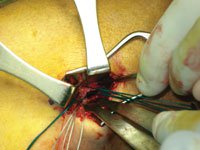Many fixation, technique choices exist for the management of distal biceps injuries
Studies give no definitive answers on the superiority of one- vs. two-incision approaches.
Surgeons have numerous options for treating distal biceps injuries, and each approach has its own challenges and advantages, according to a Columbia University investigator.
“We have so many options including the approach, either a single-incision or a two-incision,” Christopher S. Ahmad, MD, said during his presentation on the management of distal biceps injuries at Orthopedics Today Hawaii 2009. “And then we have choices of fixation with a whole host of bone tunnels, suture anchors, cortical buttons or interference screws.”
Single incision
Ahmad noted that operative treatment is indicated for healthy patients, between 40 and 50 years- old with a confirmed rupture, acceptable medical risks and high demands on their elbow.
Surgeons using a single-incision technique should visualize and protect the lateral antebrachial cutaneous nerve, he said. To expose the tuberosity, surgeons must ligate the radial recurrent vessel. The approach also calls for a limited amount of retraction.
“With this approach, you should not put retractors around the radial neck to avoid a PIN (posterior interosseous nerve) injury,” Ahmad said. He noted that a one-incision approach described by Ken Yamaguchi, MD, using suture anchors allows surgeons to deliver the tendon against the bicipital tuberosity which may aid the biology.
|
|
Images: Ahmad CS |
Two incision
Two-incision approaches give surgeons a better exposure to the radial tuberosity while providing less risk of PIN injury. With this approach, surgeons expose the bicipital tuberosity by dissecting the extensor muscles.
“Care should be taken not to expose along the ulna,” Ahmad said. “If you expose the ulna, in addition to the radius, you can increase your chance of having heterotopic ossification or radial ulnar synostosis.”
Ahmad said he protects the repair postoperatively. “Extension puts tension on the repair, so if you feel like you need to protect the repair, especially with bone tunnels which may not be as strong as other fixation techniques, block extension during the early part of their healing and then begin active range of motion,” he said.
He added, “There are many studies that support single-incision approaches showing good results. Reported complications include transient paresthesias and lateral antebrachial cutaneous nerve and PIN palsies which typically resolve. There are also many reports that support the two-incision approach.”
Fixation
He noted that a recent study comparing a two-incision approach using bone tunnels with a single-incision approach using suture anchors revealed better range of motion with the single-incision construct, but superior strength in the two-incision group. “There are still not definitive answers on which technique is better,” Ahmad said.
In addition to suture anchors and bone tunnels, fixation methods for distal biceps injuries include interference screws and cortical buttons. Ahmad noted that recent biomechanical research comparing suture anchors to bone tunnels found that suture anchors provided stronger fixation. In another study, investigators examining different fixation techniques under cyclic loading found that cortical buttons showed the greatest load to failure, followed by suture anchors, bone tunnels and interference screws.
For more information:Reference:
- Christopher S. Ahmad, MD, associate professor of orthopedic surgery, Columbia University, Center for Shoulder, Elbow and Sports Medicine, can be reached at 622 W. 168th St., New York, NY 10032; 212-305-5561; e-mail: csa4@columbia.edu. He received grant research support from Arthrex Inc.
- Ahmad CS. Management of distal biceps injuries. Presented at Orthopedics Today Hawaii 2009. Jan. 11-14, 2009. Kohala Coast, Hawaii.


